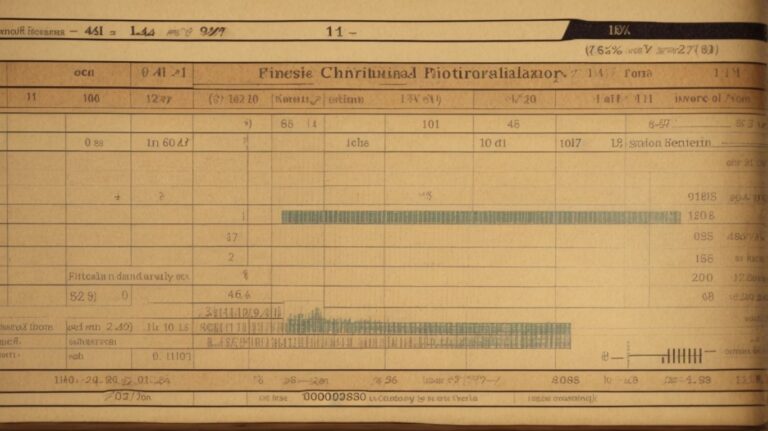If you’ve ever taken a psychology test or assessment, you may have come across the term “T scores.” But what exactly are T scores, and how are they calculated?
In this article, we will delve into the world of T scores in psychology, exploring their purpose, calculation, and interpretation. From understanding what T scores measure to the different types of T scores and their significance in psychological assessments, we will cover it all. So, if you’ve ever been curious about T scores, read on to satisfy your curiosity!
Contents
Key Takeaways:
- T scores in psychology are a standardized way to measure and compare individual test scores to a larger group.
- T scores are calculated by converting raw scores into a standard distribution and can range from negative to positive values.
- T scores provide information on an individual’s performance relative to the mean, standard deviation, and percentile rank.
What Are T Scores in Psychology?
T scores in psychology refer to standardized scores that allow for the comparison of an individual’s scores to those of a norm group.
These scores play a crucial role in psychological assessments as they provide a means for comparing an individual’s performance or characteristics with the broader population.
Derived from raw scores, T scores are transformed through a standardized process to yield a score with a mean of 50 and a standard deviation of 10, simplifying the interpretation and comparison of results.
By utilizing T scores, psychologists can assess an individual’s standing within a community norm group, enabling a comprehensive understanding of their relative strengths and areas for potential development.
How Are T Scores Calculated?
T scores are calculated through a standardized conversion process that transforms an individual’s raw scores into a standardized score on a specific scale.
This process involves several steps. The raw score is obtained from the individual’s performance on a particular test or assessment.
Then, this raw score is converted into a standardized score using a specific formula or table that relates the raw scores to the standardized scale.
The standardized score is then typically converted into a percentile rank, which indicates the percentage of people in a comparison group who scored at or below the individual’s score.
This conversion process ensures that scores from different tests or assessments can be compared on a standardized scale.
What Do T Scores Measure?
T scores measure an individual’s performance on a psychological test in comparison to the average range of scores obtained by a norm group.
This is a significant aspect of psychological assessments as it allows for standardized comparisons to be made across different tests and individuals.
T scores are especially valuable in providing insights into an individual’s psychological attributes, including cognitive abilities, personality traits, and emotional functioning.
They serve as a crucial component in various psychological inventories and assessment platforms, enabling professionals to interpret and communicate test results effectively.
T scores play a pivotal role in educational assessments and intervention planning, facilitating a better understanding of an individual’s strengths and areas of improvement.
Comparison to the Mean
T scores in psychology allow for a comprehensive comparison of an individual’s test results to the average performance of a norm group.
When T scores are compared to the mean, it provides valuable insights into how an individual’s performance deviates from the typical scores within a specific norm group.
This comparison is particularly significant in psychiatric assessments and psychological inventories as it helps in understanding where an individual stands in relation to the general population.
By using standardized psychometric processes, professionals can interpret the significance of an individual’s T score in terms of deviation from the average, aiding in making informed psychological evaluations and determining appropriate interventions.
Standard Deviation from the Mean
T scores are also used to measure an individual’s performance in terms of standard deviations from the mean score of the norm group.
This means that T scores provide a valuable insight into how an individual’s performance compares to the average scores of the reference group. The standard deviation in T scores indicates the spread or dispersion of scores around the mean, emphasizing the variability of individual performances.
Through this measurement, the distribution of scores relative to the mean can be understood, offering a clear understanding of where an individual stands in relation to the norm group.
It is an essential aspect in score conversion and standardized scoring systems, as it enables the determination of percentile ranks and interpretation of an individual’s standing in a norm-referenced assessment context.
Percentile Rank
T scores include a percentile rank component, indicating the percentage of individuals in the norm group who scored at or below the same level as the individual being assessed.
This component is crucial in understanding the relative standing of an individual’s performance. It adds valuable context by comparing the individual’s score to the entire norm group, providing insights into how they fare in comparison to others.
Percentile ranks are particularly significant in psychological inventories and assessment platforms as they allow for a more nuanced interpretation of scores.
In the context of item response theory, acknowledging the percentile rank aids in understanding the likelihood of an individual’s response to specific test items, contributing to a comprehensive evaluation of their abilities and areas of strength.
Why Are T Scores Used in Psychology?
T scores are utilized in psychology for standardization, comparison across different tests, and the ease of interpretation they offer in psychological assessments.
This standardization is essential to ensure that psychological assessments produce consistent and reliable results across different testing scenarios and environments.
By using T scores, psychologists can compare an individual’s performance on one test with the performance of a norm group, enabling them to determine where the individual falls within the distribution of scores.
This facilitates the interpretation of an individual’s psychological attributes in relation to the broader population, enhancing the precision of diagnosis and treatment planning in patient rehabilitation.
Standardization
T scores provide standardization in psychological assessments by placing individual scores on a scale that is consistent and comparable across different norm groups and test populations.
This standardization process is essential to ensure that the assessment measurements are not influenced by variations in the norm groups or populations being evaluated.
By using T scores, assessment platforms can accurately compare an individual’s performance against a standardized reference group, which enhances the interpretability and relevance of the results.
T scores allow for the comparison of scores from medical patient assessments to normed non-medical populations, enabling a comprehensive understanding of an individual’s psychological functioning within the broader context of diverse normative groups.
Comparison Across Tests
T scores enable meaningful comparisons across different psychological tests and norm groups, facilitating a comprehensive understanding of an individual’s performance in diverse assessment scenarios.
When evaluating individuals within a specific context, such as prisoner rehabilitation, T scores offer the advantage of comparing their performance against a relevant norm group.
This enables psychologists and clinicians to gauge the effectiveness of interventions and tailor treatment plans to address areas of concern.
In the realm of double-normed assessments, T scores play a crucial role in providing insights into an individual’s performance in relation to two distinct normative populations, offering a more nuanced understanding of their capabilities and potential areas of improvement.
Easier Interpretation
T scores offer a simplified and easier-to-understand interpretation of an individual’s psychological attributes, enhancing the effectiveness of assessment outcomes and interventions.
These scores, derived from standardized psychological inventories, provide a comparison of an individual’s performance relative to the normative sample. This makes it easier to comprehend and interpret results.
In educational assessments, T scores play a vital role in identifying strengths and areas of improvement for students. This enables educators to tailor interventions and educational plans effectively.
What Are the Different Types of T Scores?
T scores encompass various types, including raw T scores, standard T scores, and percentile T scores, each offering distinct insights into an individual’s assessment results.
Raw T scores represent the direct conversion of the raw scores from an assessment into a T score. They provide a clear picture of a person’s performance relative to the group they were compared against.
Standard T scores, on the other hand, are based on a standard distribution with a mean of 50 and a standard deviation of 10. These scores allow for easy comparison of an individual’s performance across different assessments.
Percentile T scores express an individual’s performance relative to others in the same group, providing valuable context for their standing in comparison to peers.
Raw T Scores
Raw T scores represent the initial unprocessed scores obtained from an individual’s performance on a psychological test, providing the foundation for further analysis and interpretation.
These raw scores have a pivotal role in the analytical process as they directly reflect an individual’s performance without any statistical manipulation, thus serving as the fundamental data points for subsequent computations and comparisons.
T scores are particularly significant in the context of percentile ranks, serving as the basis for deriving these important metrics that contextualize an individual’s performance relative to a larger population.
Understanding T scores is essential for utilizing Item Response Theory (IRT) to analyze the characteristics of test items and their relationship to examinee abilities, contributing to a more nuanced and comprehensive interpretation of psychological test results.
Standard T Scores
Standard T scores are the transformed and standardized scores derived from an individual’s raw T scores, facilitating meaningful comparisons and interpretations in psychological assessments.
These scores play a crucial role in providing a common metric for comparing an individual’s performance across various psychological inventories and assessment platforms.
The process of deriving standard T scores involves converting raw scores into values with a mean of 50 and a standard deviation of 10, allowing for standardized and comparable interpretations.
By applying item response theory principles, these scores are adjusted to account for the difficulty level of each item, ensuring accurate representations of an individual’s psychological attributes.
As a result, standardized T scores enable psychologists and researchers to gain valuable insights into an individual’s cognitive and behavioral functioning, forming the foundation for evidence-based interventions and assessments.
Percentile T Scores
Percentile T scores indicate an individual’s performance relative to the norm group, offering valuable percentile rank insights into the distribution of their scores within the population.
When an individual’s performance is represented in the form of percentile T scores, it enables a clear comparison of their standing with a larger population. These scores play a crucial role in educational assessments and are extensively used in various standardized tests.
By utilizing item response theory, these scores provide a comprehensive understanding of an individual’s relative performance, allowing educators and professionals to make informed decisions regarding interventions, placements, and educational support.
How Are T Scores Interpreted?
The interpretation of T scores involves assessing an individual’s performance as average, above average, or below average based on their standardized scores and percentile rank.
When interpreting T scores, it is crucial to understand that T scores, which are standardized scores, compare an individual’s performance to a normative group in the form of a percentile rank. A T score of 50 is considered average, indicating that the individual’s performance is similar to the normative group.
Scores above 50 indicate above-average performance, while scores below 50 suggest below-average performance.
In the context of psychological inventories and assessment platforms, interpreting T scores is essential for evaluating an individual’s strengths and weaknesses.
This process enables professionals to gain insights into an individual’s standing in comparison to a larger group, facilitating targeted interventions and support.
Average T Score
An average T score indicates that an individual’s performance on a psychological assessment is within the average range compared to the norm group.
When an individual’s T score falls within the average range, it signifies that their performance and responses align closely with the typical patterns observed within the norm group.
This interpretation is fundamental in understanding where an individual stands in relation to the broader population or the specific reference group for the psychological inventory being used.
This comparative analysis is a crucial aspect of psychological assessments, ensuring that results are not only absolute but also quantitatively depict how an individual’s performance measures up against the established norms.
Above Average T Score
An above average T score signifies that an individual’s performance on a psychological assessment exceeds the average range when compared to the norm group.
This T score serves as a crucial indicator of an individual’s strengths and abilities, shedding light on their exceptional performance in comparison to the established norm.
Typically, in double-normed assessments such as the Wechsler Adult Intelligence Scale, these above average T scores underline the individual’s standing in relation to both the general population and their specific age group.
These T scores play a pivotal role in various assessment platforms, such as the Minnesota Multiphasic Personality Inventory, providing valuable insights into an individual’s psychological makeup and functioning.
Below Average T Score
A below average T score indicates that an individual’s performance on a psychological assessment falls below the average range when compared to the norm group.
This interpretation of T scores is crucial in understanding an individual’s relative standing within a norm group. It provides valuable insights into their cognitive, emotional, or behavioral functioning.
When T scores are below average, it implies that the individual’s performance is notably lower than the typical performance observed in the normative sample. This highlights potential areas of concern or areas for further exploration in clinical or educational settings.
Frequently Asked Questions
What are T scores in psychology?
T scores in psychology are a statistical measure used to standardize test scores and allow for comparison across different tests and populations. They are most commonly used in psychological assessments to determine an individual’s performance relative to a larger group.
How are T scores calculated?
T scores are calculated by converting raw scores into a standardized score with a mean of 50 and a standard deviation of 10. This allows for easy comparison and interpretation of test scores.
What do T scores represent?
T scores represent an individual’s performance on a specific test relative to a larger group. A T score of 50 is considered average or within the 50th percentile, while scores above 50 are considered above average and scores below 50 are considered below average.
What is the advantage of using T scores in psychology?
The advantage of using T scores is that they allow for comparison of test scores across different tests and populations. This can help to better understand an individual’s performance and provide more accurate and meaningful interpretations of test results.
Is a higher T score always better?
No, a higher T score does not always indicate better performance. It simply means that the individual scored above the average of the group. It is important to consider the specific test and population when interpreting T scores.
Can T scores be used to diagnose psychological disorders?
T scores alone cannot be used to diagnose psychological disorders. They are simply a standardized measure of an individual’s performance on a specific test. Clinical judgment and additional assessments should be used in conjunction with T scores to make a diagnosis.




